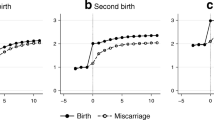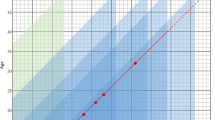Abstract
We analyze the effect of the timing and spacing of births on the labor supply of married women in a framework that accounts for the endogeneity of the labor market and fertility decisions, for the heterogeneity of the effects of children on labor supply and their correlation with the fertility decisions, and for the correlation of sequential labor market decisions. Delaying the first birth leads to higher pre-natal levels of labor market involvement and reduces the negative effect of the first child on labor supply. The effect of the second child increases with the spacing of the two births as women, returning to work after the first birth, finance child care time increasingly through reductions in market time. Individual heterogeneity is considerable; women with lower propensity for children have the first birth later in life and space subsequent births more closely together, work more before the birth of the first child, but face larger effects of children on their labor supply.
Similar content being viewed by others
References
Angrist JD, Evans WN (1998) Children and their parents’ labor supply: evidence from exogenous variation is family size. Am Econ Rev 80: 450–477
Axinn WG, Clarkberg ME, Thornton A (1994) Family influences on family size preferences. Demogr 31: 65–79
Becker G (1965) A theory of the allocation of time. Econ J 75: 493–517
Bell D (1974) Why participation rates of black and white wives differ. J Human Resour 9: 465–479
Björklund A, Moffitt R (1987) The estimation of wage and welfare gains in self-selection models. Rev Econ Stat 69: 42–49
Blau FD (1998) Trends in the well-being of American women (1970–1995). J Econ Lit 36: 112–165
Blau FD, Ferber MA, Winkler AE (1998) The economics of women, men, and work. Prentice Hall, Englewood Cliffs
Browning M (1992) Children and household economic behavior. J Econ Lit 30: 1434–1475
Carneiro P, Heckman JJ, Vytlacil EJ (2010) Evaluating marginal policy changes and the average effect of treatment for individuals at the margin. Econometrica 78:377–394
Carrasco R (2001) Binary choice with binary endogenous regressors in panel data: estimating the effect of fertility on female labor force participation. J Bus Econ Stat 19: 385–394
Cigno A (1991) Economics of the family. Clarendon Press, Oxford
Cigno A, Ermisch J (1989) A microeconomic analysis of the timing of births. Eur Econ Rev 33: 737–760
Folbre N (1994) Children as public goods. Am Econ Rev 84: 86–90
Geweke J, Keane MP, Runkle DE (1997) Statistical inference in the multinomial multiperiod probit model. J Econom 80: 125–165
Gilks WR, Wang CC, Yvonnet B, Coursaget P (1993) Random-effects models for longitudinal data using Gibbs sampling. Biometrics 49: 441–453
Gronau R (1977) Leisure, home production, and work–the theory of the allocation of time revisited. J Polit Econ 85: 1099–1123
Gustafsson S (2001) Optimal age at motherhood. Theoretical and empirical considerations on postponement of maternity in Europe. J Popul Econ 14: 225–247
Gustafsson S, Wetzels C (1997) Paid careers and the timing and spacing of births in Germany, Great Britain and Sweden. In: Tijdens K, Doorne-Huiskes A, van Willemsen T (eds) Time allocations and gender. The relationship between paid labour and household work. Tilburg University Press, Tilburg
Gustafsson S, Wetzels C (2000) Optimal age at giving birth: Germany, Great Britain, the Netherlands and Sweden. In: Gustafsson S, Meulders D (eds) Gender and the labour market. Econometric evidence on obstacles in achieving gender equality. MacMillan, London
Happel S, Hill J, Low S (1984) An economic analysis of the timing of childbirth. Popul Stud 38: 299–311
Haurin RJ, Mott FL (1990) Adolescent sexual activity in the family context: the impact of older siblings. Demography 27: 537–557
Heckman JJ, Robb R (1985) Alternative methods for evaluating the impact of interventions. In: Heckman JJ, Singer B (eds) Longitudinal analysis of labor market data. Cambridge University Press, Cambridge
Heckman JJ, Walker J (1990) The relationship between wages and income and the timing and spacing of births: evidence from Swedish longitudinal data. Econometrica 58: 235–275
Heckman JJ, Willis RJ (1975) Estimation of a stochastic model of reproduction: an econometric approach. In: Terleckyj N (eds) Household production and consumption. Columbia University Press, New York
Heckman JJ, Willis RJ (1977) A beta-logistic model for the analysis of sequential labor force participation by married women. J Polit Econ 85: 27–58
Heckman JJ, Vytlacil E (1999) Local instrumental variables and latent variable models for identifying and bounding treatment effects. Proc Natl Acad Sci 96:4730–4734
Heckman JJ, Vytlacil E (2000) Causal parameters, structural equations, treatment effects and randomized evaluations of social programs. Mimeo. UC and Stanford
Heckman JJ, Vytlacil E (2001) Policy-relevant treatment effects. Am Econ Rev 91: 107–111
Hotz VJ, Klerman JA, Willis RJ (1997) The economics of fertility in developed countries. In: Rosenzweig M, Stark O (eds) Handbook of population and family economics. Elsevier, Amsterdam, pp 275–347
Hotz VJ, Miller R (1988) An empirical analysis of life cycle fertility and female labor supply. Econometrica 56: 91–118
Hyslop D (1999) State dependence, serial correlation and heterogeneity in intertemporal labor force participation of married women. Econometrica 67: 1255–1294
Imbens G, Angrist J (1994) Identification and estimation of local average treatment effects. Econometrica 62: 467–476
Joshi H (1990) The cash alternatives to childbearing: an approach to estimation using British data. Popul Stud 44: 41–60
Keane M (1992) A note on identification in the multinomial probit model. J Bus Econ Stat 10: 193–200
Lehrer EL (1992) The impact of children on married women’s labor supply: black-white differentials revisited. J Human Resour 27: 422–444
Leibowitz A (1974) Education and the allocation of women’s time. In: Thomas Juster F (eds) Education, income, and human behavior. McGraw Hill, New York, pp 171–197
Leibowitz A, Klerman JA, Waite L (1992) Employment of new mothers and child care choice: differences by children’s age. J Hum Resour 27: 112–123
McCulloch R, Rossi P (1994) An exact analysis of the multinomial probit model. J Econom 64: 207–240
Merrigan P, St. Pierre Y (1998) An econometric and neoclassical analysis of the timing and spacing of births in Canada from 1950 to 1990. J Popul Econ 11: 29–51
Michael R (1973) Education and the derived demand for children. J Polit Econ 81: S128–S164
Miller C, Xiao JJ (1999) Effects of birth spacing and timing on mothers’ LFP. Atl Econ J 27: 410–421
Mincer J (1962) Labor force participation of married women. In: Lewis HG (eds) Aspects of labor economics. Princeton University Press, Princeton, pp 63–105
Moffitt R (1984) Optimal life-cycle profiles of fertility and labor supply. Res Popul Econ 5:29–50
Montgomery MR, Casterline JB (1996) Social learning, social influence, and new models of fertility. Popul Dev Rev 22, Supplement: Fertility in the United States: New Patterns, New Theories, 151–175
Montgomery MR, Trussell J (1986) Models of marital status and childbearing. In: Ashenfelter O, Layard R (eds) Handbook of labor economics. North-Holland, Amsterdam, pp 205–271
Nakamura A, Nakamura M (1994) Predicting female labor supply, effects of children and recent work experience. J Hum Resour 29: 304–327
Newman JL (1983) Economic analysis of the spacing of births. Am Econ Rev 73: 33–37
Newman JL (1988) A Stochastic Dynamic model of fertility. Res Popul Econ 6: 41–68
Newman JL, McCulloch D (1984) A hazard rate approach to the timing of births. Econometrica 52: 939–961
Ondrich J, Spiess CK, Yang Q (1996) Barefoot in a German kitchen: federal parental leave and benefit policy and the return to work after childbirth in Germany. J Popul Econ 9: 247–266
Ondrich J, Spiess CK, Yang Q, Wagner GG (1999) Full time or part time? German parental leave policy and the return to work after childbirth in Germany. Res Labor Econ 18: 41–74
Rodgers JL, Rowe DC (1988) Influence of siblings on adolescent sexual behavior. Dev Psychol 24: 722–728
Rönsen M, Sundström M (1996) Maternal employment in Scandinavia: a comparison of the after-birth employment activity of Norwegian and Swedish women. J Popul Econ 9: 267–285
Rosenzweig MR, Wolpin KI (1980) Life-cycle labor supply and fertility: causal inference from household models. J Polit Econ 88: 328–348
Rowe DC, Rodgers JL, Meseck-Bushey S, St. John C (1989) Sexual behavior and nonsexual deviance: a sibling study of their relationship. Dev Psychol 25: 61–69
Schoenberg U, Ludsteck J (2007) Maternity leave legislation, female labor supply, and the family wage gap. IZA discussion paper, no. 2699
Shapiro D, Mott FL (1994) Long-term employment and earnings of women in relation to employment behavior surrounding the first birth. J Human Resour 29: 248–275
Tasiran AC (1995) Fertility dynamics spacing and timing of births in Sweden and the United States. Elsevier, Amsterdam
Troske KR, Voicu A (2010) Joint estimation of sequential labor force participation and fertility decisions using Markov chain Monte Carlo techniques. Labour Econ 17: 150–169
Walker J (1995) The effect of public policies on recent Swedish fertility behavior. J Popul Econ 8: 223–251
Willis RJ (1973) A new approach to the economic theory of fertility behavior. J Polit Econ 81: S14–S64
Wolpin KI (1984) An estimable dynamic stochastic model of fertility and child mortality. J Polit Econ 92: 852–874
Author information
Authors and Affiliations
Corresponding author
Electronic Supplementary Material
The Below is the Electronic Supplementary Material.
Rights and permissions
About this article
Cite this article
Troske, K.R., Voicu, A. The effect of the timing and spacing of births on the level of labor market involvement of married women. Empir Econ 45, 483–521 (2013). https://doi.org/10.1007/s00181-012-0620-2
Received:
Accepted:
Published:
Issue Date:
DOI: https://doi.org/10.1007/s00181-012-0620-2
Keywords
- Timing and spacing of births
- Female labor supply
- Endogenous fertility decisions
- Heterogeneous children effects
- Multinomial probit model
- Gibbs sampler




